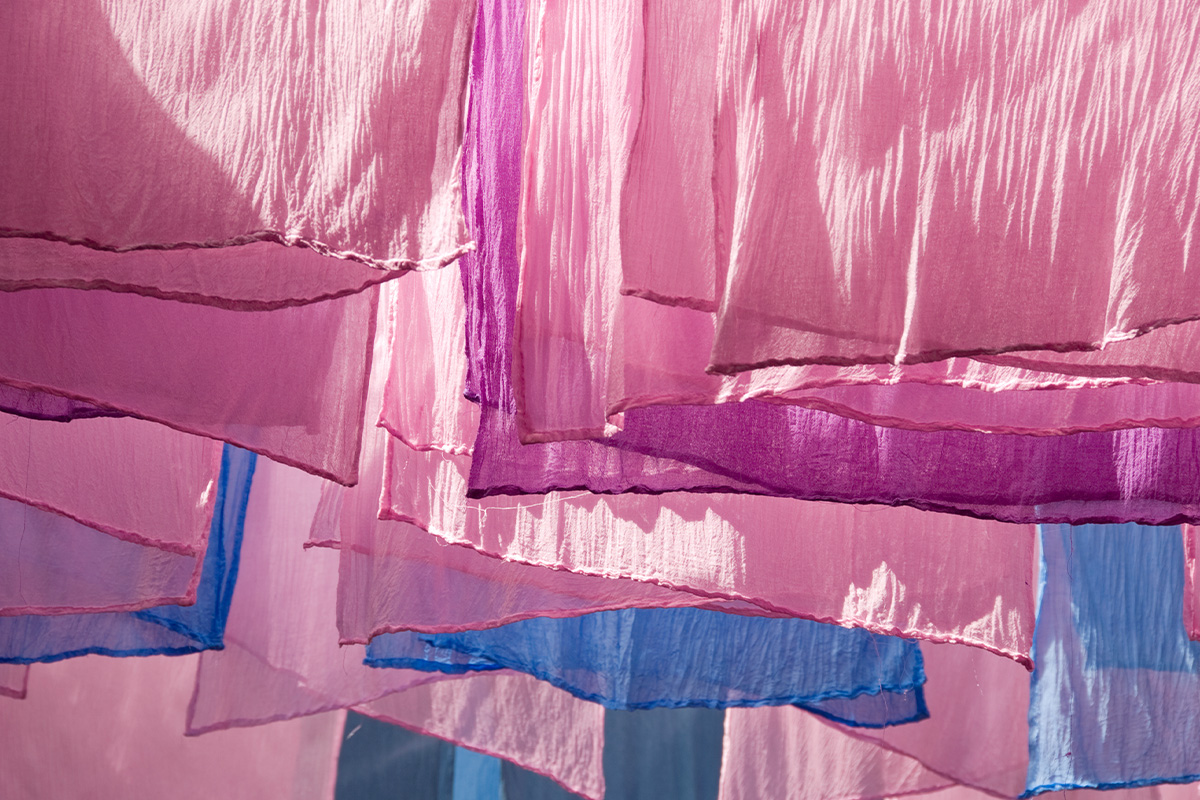Fall is here, and with it comes the Jewish High Holidays and the new year. There are many Jewish clothing traditions around the High Holidays (beyond dressing our synagogue best), like dressing in all white on Yom Kippur to signify aspiring to moral purity. During this time, ritual clothing items may find their way out of storage to be worn: prayer shawls, headscarves, kippot, and tefillin. But Jewish clothing isn’t just about what is worn in synagogue. Jews and clothing have a rich history, from decades working in the East Coast textile industry to rocking runways with iconic designers like Levi Strauss and exciting newcomers like Batsheva.
I see the Jewish new year as a time to consider my relationship with clothing and how it connects to my Jewish identity. It’s an opportunity to reclaim and genderbend ritual clothing, promote sustainability through a Jewish lens, and support small Jewish designers and makers. Here are my favorite ways to reconsider my relationship with clothing during the High Holidays:
1. Reclaiming/Gender Bending Ritual Clothing
For me, ritual clothing such as a tallit (prayer shawl) has many purposes. It connects me to my ancestors and my community. Putting it on signifies that I am physically or spiritually entering a sacred space. I also find it beautiful and comforting.
As an adult, I joined a Renewal Synagogue where it was common for women and nonbinary folk in my community to wear tallitot and kippot. I didn’t grow up wearing a prayer shawl and thought it was something I was only allowed to wear during my bat mitzvah. And I didn’t wear a kippah because I was taught it was only for men.
For the first time, I began considering what I wanted to wear to synagogue, regardless of what traditions I was taught. Today, I have a hand-weaved rainbow tallit that I made the tassels for (and prayed into while knotting). Sometimes I wear a kippah embroidered with flowers or a headscarf to services. Other times I don’t feel like wearing any ritual items at all, and I wear a crop top to synagogue because I think God loves my belly, too. But making these choices and knowing they can be fluid has been very empowering for me and my gender expression.
This High Holiday season, I invite you to think critically about what you want to wear in and out of Jewish spaces. I believe that ritual clothing items are meant to be used to help us get in touch with our personal and authentic Jewish identities. This is your invitation to try out whatever ritual item you have wondered about and see how it feels!
2. Sh’mirat Ha-Teva (Protect Nature)
As Jews, but more importantly, as people, we must protect our planet. The Hebrew word for nature is teva. And it is considered a mitzvah, or a good deed to protect nature: sh’mirat ha-teva. One of the ways we protect nature is by curbing our consumption of resources. In the U.S., 21 billion pounds of textiles are thrown into landfills yearly. During this time of year, I often feel the urge to do a big closet purge.
But instead of just donating to a thrift store (which can often also contribute to clothing eventually ending up in a landfill), I focus more on repairing clothing. I participate in clothes swaps and buy-nothing groups and patch up what I already own. Over the years, I’ve taught myself some basic sewing skills through friends and online tutorials. I love cozying up with a cup of tea on a fall day and fixing buttons on a pile of pieces. I know the most sustainable clothing choice is to wear what I already have.
I also find that the cozy vibes of fall and the Rosh Hashanah lend themselves to creating my own ritual clothes, like making a tallit or embroidering or fabric painting Jewish symbols like pomegranates or doves onto old clothing to make it feel new again.
3. Support Small Jewish Designers
But of course, there are times when buying something new or upcycled is necessary. Buying from small Jewish designers is one way I engage with my Jewishness. Around the New Year, I like to pick up some things connected to my values and dreams for the upcoming year.
For example, I buy Dreaming the World to Come, a gorgeous, magical Jewish planner, each September. The planner is organized by the Hebrew, Gregorian, and Moon calendars. Using the calendar has been a powerful tool for me to reclaim Jewish ancestral time in my day-to-day life.
I love embroidery, so in the past, I’ve commissioned earrings based on my Shabbat candles. I just commissioned a branch of cherry blossoms embroidered on my favorite bookstore tote bag from Cameron Friend at @cam__makes for my hot Jewish girl walks. I also buy my stickers and masks from Sarah Day Art (Jewish frogs, yes, please). I have yet to buy a golem stuffie from @devotaj_arts to cuddle on a crisp fall night, but I look forward to it.
There are also many fabulous Judaica jewelry designers like Jewish Latina-run @rootsmetal or Moroccan Jewish-owned @hamsa.alek. Jews have a rich history of being talented artisans, and as I can, I am honored to help support the continued tradition.
This Rosh Hashanah, take a minute to consider your relationship to clothing and Judaism. Fashion and Judaism are deeply entwined, and taking a minute in your life to see those connections is an empowering and fascinating exercise. Since I have started to see fashion through a Jewish lens, I feel more connected to my Judaism and self. I no longer see clothing as something that could be frivolous, but rather as art that can be imbued with Jewish and spiritual energy. I am more in touch with my body, gender expression, and Judaism. Who doesn’t want that?



